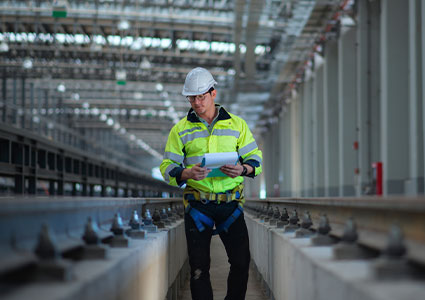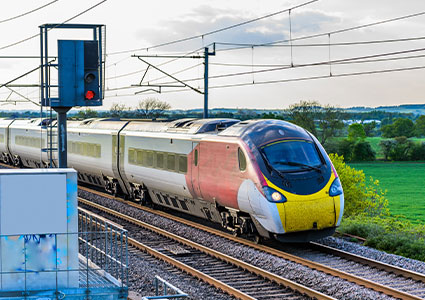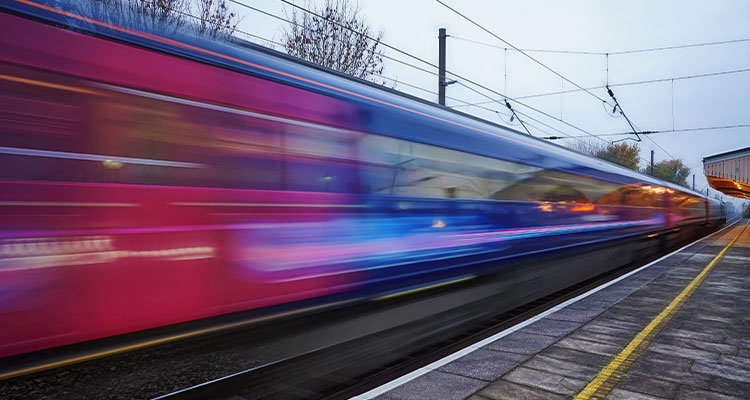A route to rail sector efficiency
The experiences of Transport for Wales and Scotland’s Railway in recent years have demonstrated the transformational potential of taking a more aligned and systemic approach to the management and development of railway operations and infrastructure.
While there is no one-size-fits-all solution, the planned reform of the UK rail sector provides an important opportunity to radically improve current industry performance, through expanding the principles of vertical integration.
The case for a vertically integrated model in the UK
Talk to any commuter, rail professional, local or national politician and their analysis of the UK’s rail industry will be similar – it’s a sector in desperate need of reform. 
The good news is that reform is on its way. The debate over whether change is needed is over; and is now firmly rooted in precisely what form reform should take. The UK appears to be heading towards a more integrated approach in which infrastructure, rolling stock and operations are treated as a single system. The long-awaited Railways Bill was confirmed in the King’s Speech and once enacted by the new administration, could lay the foundations for a new era of integration.
And while so-called vertical integration is not necessarily appropriate across the entire rail network, with a single guiding mind such as the “Integrated Rail Body” proposed by the Bill, there is increasing evidence that an integrated structure certainly holds the key to better outcomes.
The outstanding challenge is the current fragmented and siloed industry structure working towards misaligned objectives. Of course, any legislative reforms make a step towards change, but finding the right structure for better overall performance remains elusive.
In search of a systems solution
Delays to reform are hardly surprising. The railway is a complex system and any change to current arrangements must be approached with critical systemic thinking top of mind. This is neither easy nor usual. To evoke effective change, we need to be radical – breaking down those silos of activity, managing the network of track, other infrastructure, rolling stock, stations and services operated. In its place we need to create a new system-driven approach capable of delivering reliable passenger and freight services that represent value for money and at a price the nation can afford.
The reality is, for all the benefits of rail privatization, the vertically separated structure we have been left with has done little to help create a sustainable national railway. Misaligned incentives and conflicting outcomes have led to poor performance and spiraling costs.
The vertical integration opportunity
A move towards vertical integration of the railway – where the maintenance, enhancement and operation of track and other infrastructure, trains and services are under the control of a single guiding mind – provides a route towards the vital system thinking needed to underpin the changes Great British Railways (GBR) are tasked with.
GBR’s grand plan intends to revitalize the network by making ticketing simpler, maintenance more efficient and train services more integrated and reliable. Time will be needed to work through the details of the transition and enable all parts of the supply chain and every delivery organization to get ready to embrace the change.
This will be difficult. Privatization was implemented using a vertically separated model, where the management of the wheel and rail was deliberately split between a single infrastructure body and a plethora of train operators.
But for today’s modern rail systems where, for example, signaling systems are moving from the track to the train and power is moving on board with hybrid power systems, this separation increasingly stands in the way of efficient and effective railway outcomes.
The future success of the railway is not about ownership – this is not a public vs private issue; from a systems thinking perspective, the current structure has created sub-optimal infrastructure and operating silos.
Industry costs and overall public subsidy levels are now much higher than pre-privatization, and international benchmarking of infrastructure maintenance and renewal unit costs reveal a significant increase in UK costs relative to other countries.
A recent international research consortium study, led by Dutch transport consultant Inno-V, into the Economic Effects of Vertical Separation in the Railway Sector concluded that while no single model guarantees success, vertical separation inevitably increases industry costs.
Integrated success
 Currently, there are several vertically integrated light rail systems in the UK, notably Docklands Light Railway and Manchester Metrolink, which Amey is involved with in partnership with Keolis, and the Tyne and Wear Metro. All have demonstrated what can be achieved with vertical integration and greater alliancing between the public and private sector. The Metro in particular, which transitioned to vertical separation in 2010 but subsequently reverted to a vertically integrated model in 2017.
Currently, there are several vertically integrated light rail systems in the UK, notably Docklands Light Railway and Manchester Metrolink, which Amey is involved with in partnership with Keolis, and the Tyne and Wear Metro. All have demonstrated what can be achieved with vertical integration and greater alliancing between the public and private sector. The Metro in particular, which transitioned to vertical separation in 2010 but subsequently reverted to a vertically integrated model in 2017.
On the heavy rail side, the only meaningful example of vertical integration was instigated by the Welsh Assembly Government in their award of the Wales & Borders franchise in 2018 to KeolisAmey. In choosing this innovative route, Transport for Wales created a whole system approach which maximized the benefits from public and private thinking and investment.
While the operation element was transferred to Transport for Wales because of the Covid pandemic, delivery of the South Wales Metro upgrade and maintenance of the Core Valley Lines (CVL) remained with Amey.
Transport for Wales and Amey have subsequently demonstrated that change is possible and strong public-private partnerships operating under aligned objectives are productive, bringing together infrastructure, rolling stock and operational expertise to deliver an integrated, outcome-driven railway.
Looking beyond the public-private question
CVL has shown that true alignment of objectives across the supply chain drives success. And most certainly, it has demonstrated that success is not a public versus private issue.
Transport for Wales made a bold decision to embrace the opportunity for vertical integration and, perhaps, as a new organization without baggage from the past, pressed forward with the supply chain to make it work.
And there were risks that had to be managed on CVL. The single team had to secure service quality by establishing robust coordination and aligned incentives, translating the needs of the passengers into the delivery and management of rolling stock and infrastructure. Affordability and cost efficiency had to be balanced against speed and responsiveness to delays. Plus, of course, the need to manage the interfaces with the wider UK rail network.
But the benefits of this vertically integrated approach were clear. For example, by aligning incentives between the needs of track, trains and passengers, an innovative electrification solution has been achieved without the cost, disruption and carbon impact of significant infrastructure changes. Detailed analysis of data optimized train performance, and the team was able to invest in hybrid, battery power rolling stock and new power management technology.
One size does not fit all
Building on the Welsh experience, breaking up the whole of Network Rail into a group of vertically integrated companies in one hit would certainly represent a bold move, but would also be an incredibly complex transformation that would come with significant risk.
But this is not a one-size-fits-all situation. Wider re-introduction of a vertically integrated model would have to be assessed against each specific environment to ensure delivery of benefits in terms of cost efficiency and operational performance. Greater clarity over desired outcomes nationally, regionally and sub-regionally is still required to enable integration between the different parts of the railway to be truly effective.
Opportunities for change
That said, there are several potential regions and networks that offer a clear rationale for following the lead taken by Transport for Wales including Merseyrail, Anglia and the already partially vertically integrated London Overground network.
Different integrated models will suit different regions and operators. Scotland’s railway, while not strictly vertically integrated, has in the last few years benefitted significantly from having Alex Hynes (now Director General, Rail Services, at the DfT) leading operational and infrastructure entities, with both organizations aligned to the delivery of a single objective.
Whatever the desired outcome, we ultimately will always come back to the same conclusion – unless you control the trains and the track then the innovation required to radically improve outcomes for passengers is made difficult, if not impossible. Now is the moment to embrace the power and enthusiasm of both the public and private sector and create a new set of systems and structures that take the UK rail network into the future we all want.
For a list of the sources used in this article, please contact the editor.
James Holmes
www.amey.co.uk
James Holmes is Rail Sector Director for Amey. Amey is a leading provider of full life-cycle engineering, operations and decarbonization solutions for transport infrastructure and complex facilities.
